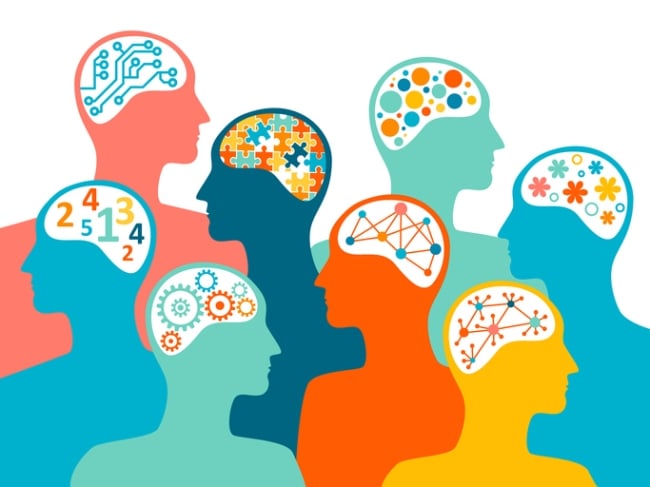You have /5 articles left.
Sign up for a free account or log in.

Iryna Spodarenko/istock/getty images plus
Being autistic in this world is not always easy. Neither is being autistic in academe -- regardless of whether you are student, faculty or staff. I know because I am autistic and have held all three of those roles.
I was first diagnosed in my mid-20s, more than 20 years ago. At the time, my diagnosis was Asperger’s syndrome, and I frankly assumed it was a mistake. I thought I knew what Asperger’s looked like, and I was sure the psychologist was wrong. He wasn’t, but it took more than 20 years and an updated diagnosis for me to accept it. In understanding my own autism and figuring out how to work with both my own neurodiversity and that of the students I teach, I’ve learned the following.
Autism truly is a spectrum. Various diagnostic tests and expert resources can identify two dozen or more possible markers of autism. A person on the spectrum may experience few, some or all of them -- and may experience each at different levels of intensity. We often say that if you know one person on the spectrum, you know one person on the spectrum. While we often have identifiable similarities, we can be quite different from one another, too, so what you think you know about autism may or may not be accurate for your student. It’s wise to be mindful of such preconceived ideas and take each student as they are rather than as you think they will be.
Many of us are women and nonbinary people and people of color. Young, awkward white man: that’s the classic image of what an adult self-advocate on the spectrum looks like. But autism affects people of all races, genders and ages -- and we can be diagnosed at any age. Adult diagnoses of autism and women diagnosed with autistic spectrum disorders are both on the rise, in part because the focus has always been on studying and diagnosing children, and in part because, as recent studies have found, autism can look very different in girls, women and nonbinary people than in men. Be aware that the students you might assume can’t be on the spectrum really might be.
Most adult self-advocates prefer identity-first language. Educators, social services professionals and health-care workers are almost always taught to use person-first language (person with autism). In fact, most academic journals won’t publish anything else. Yet the vast majority of adults with autism who can state their preference say that they prefer identity-first language (autistic person). To us, autism is as much a part of who we are and how we interact with the world as any other facet of our identity. It’s not something we can pick up or put down at will; it’s an integral part of our day -- every day. If you’re not sure which your student prefers, just ask. If someone prefers person-first, absolutely use it, but please do give us the choice.
Challenging our diagnosis is not OK. Diagnosis challenge happens a lot to neurodiverse people with low support needs (sometimes labeled as “high-functioning,” a term many of us also dislike) and those with few obvious autism markers. But while it’s true that autism impacts some people’s day-to-day functioning more extensively than others, it really does affect each one of us on the spectrum -- every single day. In addition, the more sophisticated the processes and coping mechanisms we’ve developed, the more likely no one around us will even notice our autism.
Also, most of us with low to moderate support needs have learned to hide or suppress socially unaccepted aspects of our behavior to some degree, and some of us are very good at it. As a result -- and again due to all those stereotypes -- people often don’t accept our diagnosis once they’re told of it. That is a huge problem, not only because of access and equity issues, but also because people with low support needs often question their own diagnoses as well. This can keep us from accepting, understanding and learning to move through the world in cooperation with our autism instead of denying it. You can help students struggling to accept and manage their autism by accepting it yourself.
Not all of us experience developmental delays. In fact, even most autistic people who are mute or situationally mute don’t have developmental delays. But our brains do work very differently. We’re often maddeningly (to you) linear and strict in areas most people leave to chance, but we instinctively and quickly pick up on -- and extrapolate with surprising (to you) accuracy -- things most people need spelled out step by step. Because we don’t necessarily process information in the same way neurotypical people do, and we can’t always articulate what’s in our heads in a way neurotypical people can understand -- and because of the stereotypes surrounding autism -- people sometimes make assumptions about our intellectual capabilities.
Those assumptions are often inaccurate. If a student has disclosed their autistic spectrum disorder, you can simply ask what they struggle with and what they might need. Accommodations and adjustment forms don’t always cover all the bases.
The average classroom is not autism-friendly. My classroom is incredibly noisy -- if you’re me. Besides the constant buzz of the fluorescent lights, every computer in my room hums, as does the projector. It’s so distracting that I turn all of it off when I don’t have students. But it’s still distracting when I have a class in session, and teaching while trying to ignore the noise can be exhausting.
Moreover, something in the wall buzzes nonstop throughout the day, and it’s noticeable enough to me that I have to actively resist the urge to try to talk over the noise. Yet none of my neurotypical colleagues noticed it until I pointed it out. If teaching in such as environment is difficult and tiring, how much less conducive to learning must it be? And what noises in your classroom might you not even have noticed?
Questioning isn’t challenging. Unless we’ve been forcefully schooled against it -- and that happens a lot -- a person on the spectrum is likely to keep asking questions until whatever you’re trying to tell us makes sense to us. That point may come long after whatever you’re saying makes sense to you and possibly well after it makes sense to your neurotypical students. This is not a challenge to your authority, and it isn’t willful ignorance. If we’re still asking, either it’s just not clicking for us or there’s a gap in your communication that others are automatically filling in or a flaw in your logic that others either haven’t noticed or are ignoring. Try to react with that in mind. Your anger or frustration only baffles us into frustrated silence, and that isn’t helpful for anyone.
Your disorganization is our chaos. All people, whether we realize it or not, rely on a set of processes and routines to get through each day, each project, each semester. That is especially true of people on the spectrum. We usually learn early on that the best way to navigate a world that doesn’t think, feel or behave as we do -- and often doesn’t understand us and doesn’t want to -- is to create a series of interdependent processes and then test and refine them till they work consistently.
Obviously, some change in the classroom is inevitable, and sometimes it is necessarily quite sudden. But it’s important to realize that even those of us with a high tolerance for change and ambiguity have a hard time with sudden shifts in deadlines that force us to restructure our plan for getting work done, assignments that appear out of nowhere (or disappear without a whisper) and changes to online course organization. The more organized and consistent you are as an educator, the more successful your neurodiverse students are likely to be. Please keep this in mind when you design your classes -- and when you find yourself needing to make a change.
Navigating the neurotypical world can be exhausting. Masking -- hiding or suppressing our autistic behaviors for the sake of social acceptance or personal peace -- is exhausting. The constant worry that the mask will slip is exhausting. So is trying to understand the frequently confusing and conflicting messages neurotypical people seem to navigate with ease. For many of us, exposure to environmental factors from lighting to smells to sounds to electricity takes energy most people can’t even fathom -- especially if we’re trying to mask and go about our daily business successfully. Contrary to the stereotype that paints people on the spectrum as lacking in empathy, many of us are also highly sensitive to other people’s emotions, and that can wear us out quickly, too.
No matter who you are, nothing works as well when you’re tired. That’s true of us, too. The harder and longer we have to work to stay masked, to ignore that hum in the wall and so forth, the more likely our processes and coping mechanisms are to fail. Please remember that when dealing with us and give us a bit of grace when you can.
Adapting for us can make the educational experience better for everyone. Traditionally, a lot of faculty members have thought of accommodations as something that gets in the way of business as usual, that disrupts the “normal” operations of the classroom and creates more work for the people in charge. But often, working to develop and incorporate accommodations is exactly the kind of disruption necessary to make things better for everyone. When we ensure our videos include closed captioning for people who are deaf and hard of hearing, we also provide support for English language learners and people who don’t process auditory input as effectively as visual input. In ensuring all our documents can be read by screen readers used by blind and visually impaired people, we also provide support for single working moms who can now listen to lessons in the car or while fixing dinner. The things those of us on the spectrum need will benefit everyone, as well: more precise communication, well-organized material, clearly defined expectations and rules, fewer distractions, and acceptance. Just imagine how much more peaceful and effective your classes could be.
Research on how autism presents in and affects adults -- particularly girls, women and nonbinary people -- remains slim, but the body of knowledge is growing, and everyone does seem to agree that the experience of being autistic is complex. Social media like Twitter, Instagram and TikTok have given people on the spectrum a platform we haven’t had before, and many of us use it. So if you want to learn more about what life and learning are like for us, try searching Twitter or Instagram for the #ActuallyAutistic hashtag. Also read the latest articles. Ask someone on the spectrum to share. The Autistic Self-Advocacy Network has several excellent resources as well. Check them out. There are more of us out there -- and in your classroom -- than you might think.




